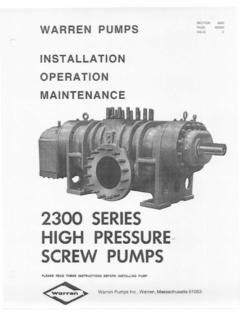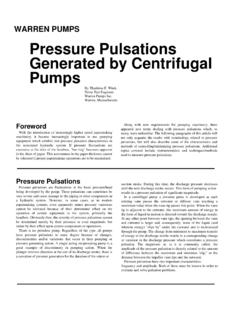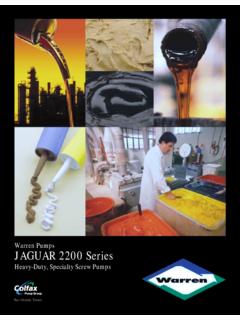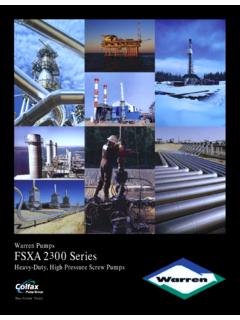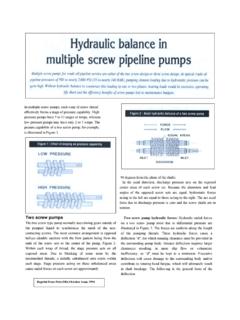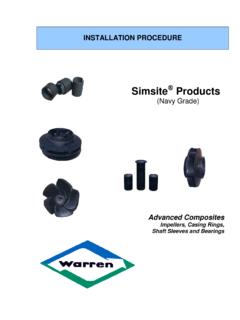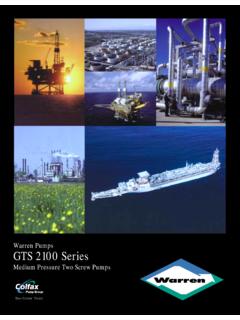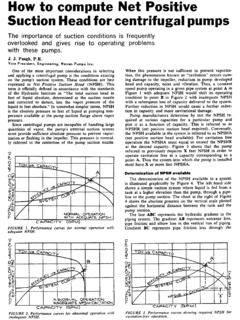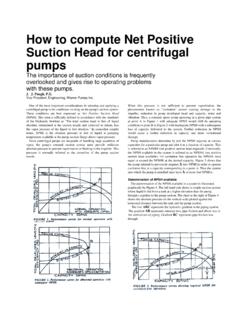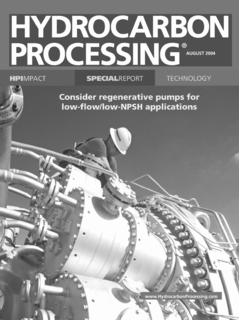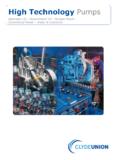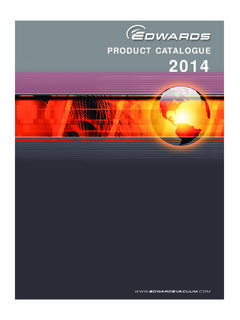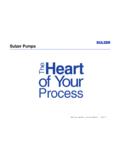Transcription of High Temperature Twin Screw Pumps Rev 2 - …
1 high Temperature twin Screw Pumps By: David B. Parker Two Screw Product Engineer IMO Pump Warren Warren, Massachusetts David B. Parker is the Two Screw Product Engineer for IMO Pump - Warren, in Warren, Massachusetts. His responsibilities include pump specification and system design for IMO Pump Group s two Screw product lines. He was the Senior Chemist at Luvak Laboratory for eight years before joining IMO Pump Warren. At Warren, he was a field service engineer for two years, became the Application Engineer in 1989, and Manager of Research and Development in 1992. He became the Two Screw Product Engineer in 1997. Mr. Parker received his degree from the University of New Hampshire (1979) and is currently enrolled at Western New England College. He is a member of ASM International. ABSTRACT high Temperature applications present many engineering problems.
2 Thermal growth of piping and vessels, coupled with typically lower viscosities at high Temperature , has made centerline mounted centrifugal Pumps the primary choice in hot applications. Two Screw Pumps offer extended viscosity ranges, can handle entrained gases, and require less inlet pressure than centrifugal Pumps . Two Screw Pumps have earned a reputation of reliability over several decades of high Temperature service in demanding applications. CENTRIFUGAL Pumps Centerline mounted centrifugal Pumps are designed to grow radially from their shaft centerline outwards. Internal operating clearances are large relative to the thermal expansion. These Pumps have a good reputation for being reliable performers and work well in many installations. Centrifugal Pumps can handle a wide range of operating conditions. They can run on viscosities ranging from less than one centipoise solvents to several hundred centipoise.
3 Single stage Pumps can handle high flow rates at relatively low heads, and multistage Pumps can handle high head applications. These Pumps are relatively inexpensive and should be the first choice when application requirements can be met. Centrifugal Pumps do become limited when viscosities rise above a few hundred centipoises. The pump head, capacity, and efficiency all fall until the pump can no longer get fluid into the impeller. Conditions at start-up may include viscosities beyond the capability of a centrifugal pump, even though the centrifugal could handle the normal operating mode. On systems that have very few shutdowns, it may be practical to have an auxiliary system dedicated to bringing the main system on line. Centrifugal Pumps operate on a head-capacity curve. When system pressures change, the flow rate changes.
4 For transfer services this is acceptable, but it leads to difficulty in controlling exothermic reactions. The ability to control flow independent of pressure adds safety and control to batch reactor operations. Net positive suction head limitations are common in high Temperature applications due to boiling points of some constituents. In tower or reactor applications, the NPSH available may only be the static height of the liquid. If there is any viscosity to the fluid, centrifugal Pumps may not be able to operate without cavitation. Positive displacement Pumps typically have much lower inlet requirements then centrifugal Pumps . Entrained gas can cause problems for centrifugal Pumps . As the fluid enters the eye of the impeller, the pressure drops and the entrained gas expands. The gas has a low density, so the impeller cannot add enough kinetic energy to exit the impeller and enter the volute.
5 The impeller becomes vapor bound and the pump stops pumping. Screw Pumps can operate successfully with entrained gas because they move a volume by enclosing it rather than accelerating it. TWO Screw Pumps When the above limitations are encountered, a centrifugal pump can no longer meet the application demands. At that point, a two Screw pump should be considered. Two Screw Pumps are a more complex piece of machinery than single stage centrifugal Pumps , but when the above limitations are encountered, the system is already a fairly complex environment. The addition of a two Screw pump can simplify the operation of the system by maintaining a constant flow rate while other variables change. Two Screw Pumps have been around since the early 1950s and have been used in high Temperature applications for almost as long. Asphalt transfer was one of the early applications.
6 As the chemical industry expanded in the 1970s, new applications arose. Polymers, rubbers, and adhesives were manufactured in many locations and by many different methods. Currently, there is a move toward large facilities devoted to individual products. This requires large scale equipment with greater reliability. The foreseeable future includes more exotic materials and greater environmental controls. TYPICAL REFINERY SERVICES Asphalt transfer is a typical high Temperature two Screw pump application. temperatures range from 300 F to 500 F (150 C to 260 C) and viscosities range from 100 to 5000 SSU (20 to 1000 cp). Flow rates are from a few hundred to a few thousand gallons per minute at discharge pressures of 100 to 200 psig. Two Screw Pumps can handle the normal range of operations and also the upset conditions encountered when asphalt starts to cool down.
7 As the Temperature drops, the viscosity rises rapidly. If the asphalt cannot be pumped out, the vessel or container is at risk of having the asphalt solidify. Two Screw Pumps become more efficient as the viscosity increases and the discharge pressure increases, whereas a centrifugal pump would lose capacity, efficiency, and start cavitating. Hydrocarbon processing utilizes two Screw pump technology at the end of the refining process. Vacuum tower bottoms is a service characterized by very low net positive inlet pressure available (NPIPA), low to moderate viscosities, and the potential for entrained gases. During steady state operation, the available suction pressure is only the static height of fluid in the tower. Viscosity is low and discharge pressure is low. When the viscosity increases, either due to lower Temperature or heavier crude oil, more gas is entrained in the higher viscosity fluid.
8 Discharge pressure also rises due to additional pipe friction loss at the higher viscosity. Start-up conditions can include low or high viscosity depending on the system, and upset conditions can encompass very high viscosities. Two Screw Pumps often have drivers sized for the worst upset condition so the system can be restarted even at ambient temperatures . The Rose process is an asphaltene process that operates at relatively high Temperature , viscosity, flow rate and pressure. Typical values are 550 F, 1000 to 4000 cp viscosity, 2000 gpm, and 500 psi pressure. These conditions are well suited to two Screw Pumps , and mechanical efficiencies at these conditions are typically 70 to 80 percent overall efficiency. TYPICAL CHEMICAL SERVICES high viscosity polymers dominate the chemical applications for high Temperature two Screw Pumps .
9 Many polymers have low viscosity solvents in the reaction, and these solvents have high vapor pressures at elevated Temperature . The inlet pressure may be substantial, but the NPIPA is only the static height of fluid in the reactor. The reactions are frequently exothermic and require a pump to circulate the product from the reactor vessel, through a heat exchanger, and back to the reactor vessel. The pump must be capable of handling very low to very high viscosities with very low NPIPA. Batch reactors also need to be pumped out after each batch so the pump must be able to strip the vessel and run dry. Solvent or caustic cleaning cycles are required. All wetted components are usually stainless steel or other corrosion resistant materials. Polymers that are manufactured with solvents frequently have an evaporator draw off service. This process involves subjecting the product to high Temperature and high vacuum in an attempt to boil the solvent phase out of the polymer.
10 The polymer product is removed from this process by a two Screw pump operating on high viscosity polymer with very low NPIPA. Center suction, hopper style pump suction inlets have handled inlet pressures below one psia. Many polymers are shear sensitive. If the product is exposed to high shear rates, the desired physical properties may be changed. Emulsions are sensitive to droplet size and dispersion. Two Screw Pumps are successful in these applications due to the laminar flow of the product within the pumping cavities. There is very little mixing in the pumping action so the physical properties of the product are not altered. Polyester manufacturing plants are being designed with higher capacities, but they still require constant flow rates as variables change. Larger Pumps have been designed to accommodate these services with flow rates of several thousand gallons per minute of hot, viscous product.
